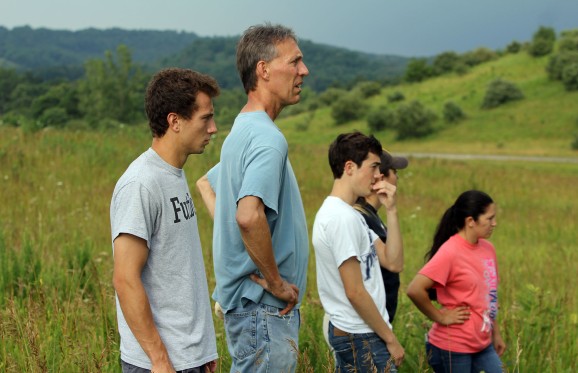Learning
Biology students, faculty study grassland habitats at The Wilds
Several Muskingum University students teamed up with faculty members over the summer and fall to follow the progression of grassland habitats for various bird species at The Wilds. The data collected is part of an ongoing research project tracking the changes in bird ecology and habitat use over time.
Muskie Fellows Allissa Brown ‘19, of Newark, and Donny Ingold ‘20, of Cambridge; Alex Furst ‘19, the Anderson Fellow of Bay Village; and Jolyn Shunk ‘20, the Lovejoy Fellow of St. Clairsville; collected and analyzed data at the The Wilds in Cumberland, Ohio. For several weeks, they worked alongside Dr. James Dooley, the Bill and Martha Lovejoy Distinguished Professor in Biology and Dr. Danny Ingold, the Homer A. Anderson Distinguished Professor in the Natural Sciences.
“There are a group of birds called grassland birds that need extensive grasslands to survive and to reproduce,” Dr. Ingold explained. “The habitat at The Wilds is slowly turning to a sort of woodland, so we’ve been following the progression and the change of the habitat and the numbers of individuals of each of the species of birds over the years.”
The project first began in the summer of 1997 and has followed the progression of habitat change each summer since with the help of Muskingum students. In some years the teams have followed birds by putting plastic colored bands around the birds’ legs and tracking them from year-to-year. They’ve also monitored the birds’ reproductive success.
As The Wilds has transitioned, some of their habitat from the exotic, cool season grasses planted when the land was originally reclaimed, to warm season, native prairie, which contains very tall plants, Dr. Ingold, Dr. Dooley and team have been tracking the influence on the bird species long term.
“The bottom line is, the birds don’t look for individual species of plants, they look at the structure of the habitat,” Dr. Ingold said. “If the structure fits them, they’ll go there.”
Although, when specific plants, called Autumn Olive, get too thick, birds such as the Henslow’s Sparrow, a bird on the Ohio Department of Natural Resource’s “Species of Concern” list, begin to disappear.
A bonus to the program each year is the opportunity to get to know students, many of whom are first or second-year Muskies.
“When we’re out in the field with them, we talk about everything,” Dr. Dooley said. “It creates a kind of accelerated connection and a cohesion with them and our program.”
In addition to the research questions, one of our goals is to give students a sense of what science is like beyond the stuff that they read about in their books, Dr. Dooley explained.
“The Muskingum fellowship provides hands-on learning and an experience that they can put on their resume so that when they apply for an internship or a research experience elsewhere, their record is much stronger,” he said.
“Making the grades is a good thing, but employers want to know the people they’re going to hire can do something, can do the work,” Dr. Ingold added. “So these experiences show students that they can get out, and put their knowledge to the test.”
The grassland habitat project is one of several projects undertaken by a group of students and faculty over the summer. The Muskingum University summer fellowship program selects students to work side-by-side with faculty on research and study that will make positive impacts on our surrounding communities and the world.
Known as “Muskie Fellows,” the students selected to participate in the program receive a stipend and University housing for the summer. In 2017, there were seven student-faculty collaboration projects, ranging in focus from Music Education to Biology.